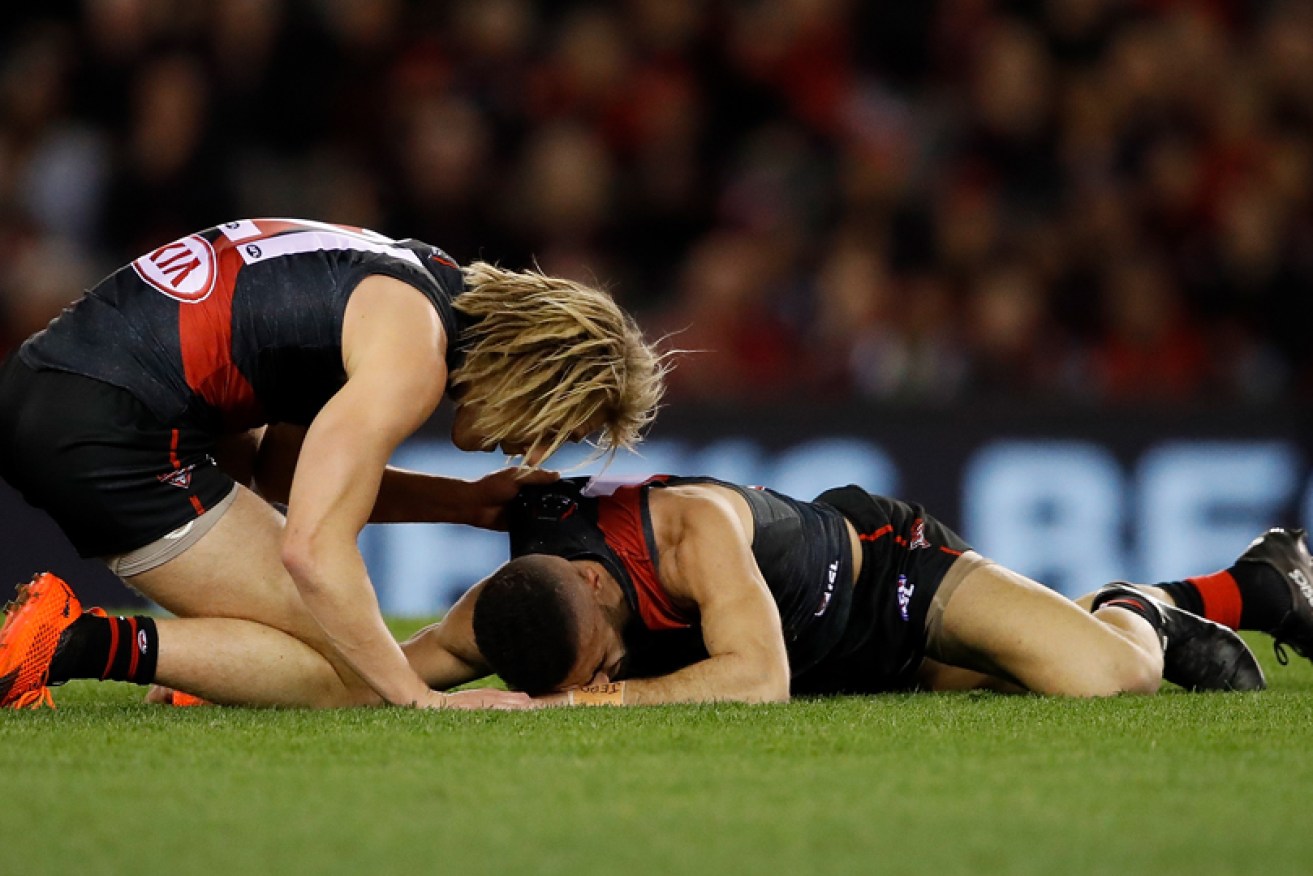AFL red cards: Why fans have every right to be angry


Because of curious rules, the felling of Adam Saad on Friday left Essendon a man down. Photo: Getty
How long will the AFL continue to do nothing about on-field acts that should result in immediate expulsions from games?
On Friday night I watched from the stands at Melbourne’s Etihad Stadium as yet another AFL player was taken out of a match by an illegal act with no immediate consequences for the offending player’s team. In fact, they benefitted.
When St Kilda’s Nathan Brown flattened Essendon’s Adam Saad with a late bump off the ball in the first quarter of their match, he immediately boosted his side’s chances of winning and reduced those of the opposition.
Not only had he effectively removed one of the opposition’s most dangerous players, reducing Essendon to 20 fit men – Essendon’s Brendon Goddard had already hobbled from the field never to return that night – Brown did so with impunity, thanks to the AFL’s curious concept of fairness.
The St Kilda defender will face the tribunal on Tuesday night and should get at least a three-week penalty.
Almost from the moment Saad was felled, the debate about red-carding in the AFL took off again. It had dominated football media the week before when West Coast’s Andrew Gaff severely injured Fremantle’s Andrew Brayshaw with a punch to the face, ending his season.
It didn’t end with Saad either. Just twenty four hours after concussion forced him from the ground, GWS Giants’ star, Josh Kelly, was knocked out in a Taylor Walker sling tackle. Adelaide’s Walker played on, Kelly never returned to the game.

Essendon players let St Kilda’s Nathan Brown feel their displeasure after the hit. Photo: Getty
Unlike many other sports, AFL football refuses to order off players for on-field indiscretions.
As far as I can tell, under the laws of the game someone could kill an opposition player and providing the police didn’t show up and arrest him, he’d be allowed to play on. As I said, curious.
Predictably, the debate after the Saad incident became mired in the usual pros and cons, with advocates warning a grand final could one day be determined by an illegal act and opponents cautioning that someone could mistakenly be sent off at great cost to their team if red cards were introduced.
As one of my Twitter followers wrote on Sunday night: “My amateur club had a player red-carded in a grand final. We got run over in the dying minutes. He went to the tribunal and was cleared. Not sure I support red cards.”
As it turns out, I do support red cards. But point taken.
I can see football fans are never going to agree on this and AFL stakeholders probably won’t either, so maybe we have to consider a different approach that doesn’t focus on ejecting errant players but on replacing those who’ve been illegally forced from the field.
This approach would address at least half the inequity that flows from these illegal acts in that it would allow the team adversely affected to restore its numbers. At the moment they’re prevented from doing that.

Saad may have given the thumbs up as he was carted off, but his team was left severely disadvantaged. Photo: Getty
It would mark something of a return to the traditions of the game, which the AFL tells us is important to them.
For most of its long history, VFL football – the antecedent of today’s AFL – had 18 players on the field of play and two on the bench to cover injuries or if the coach decided on a replacement for tactical reasons. Once replaced, a player could not return to the game. In that sense the two extra players were substitutes, not interchanges.
In the late 1970s however the VFL allowed clubs to interchange the two reserve players, and coaches instituted rotations for the first time. The idea of substitute players was lost until the AFL re-introduced the concept in 2011, allowing for three players to be used as interchange players and a fourth player to be designated as a substitute.
I always thought it was a good rule, given AFL is a brutal sport that is too often decided by attrition. The game’s guardians abandoned substitutes in 2015 however, leaving teams who lose a player to injury during a match to continue a man down. Don’t ask me why.
With the red card debate raging, the simplest way forward for the AFL would be to re-introduce the concept of substitute players. I’d go with two who could be used to replace anyone removed from the game by fair means or foul.
That would mean a six-man bench – four interchange players and two substitutes. If it had been in force on Friday night, Essendon could have covered Saad, lost through Brown’s illegal act, and, for that matter, Goddard.
If that is too dramatic for the AFL then simply allow clubs to nominate one emergency substitute who can only be used if a teammate is forced from the field illegally.
Of course, teams could go weeks, even entire seasons without using the sub. But on the rare occasions they did it would partly appease fans who look at incidents like the felling of Brayshaw and Saad and are left seeing red.
Bruce Guthrie is co-founder of The New Daily. You can follow him on Twitter @brucerguthrie








